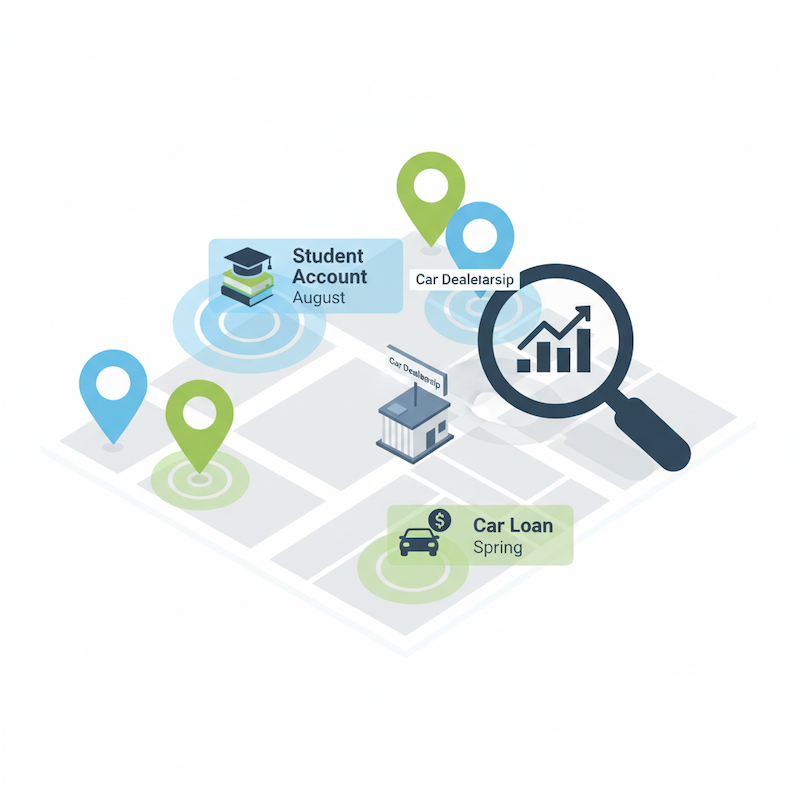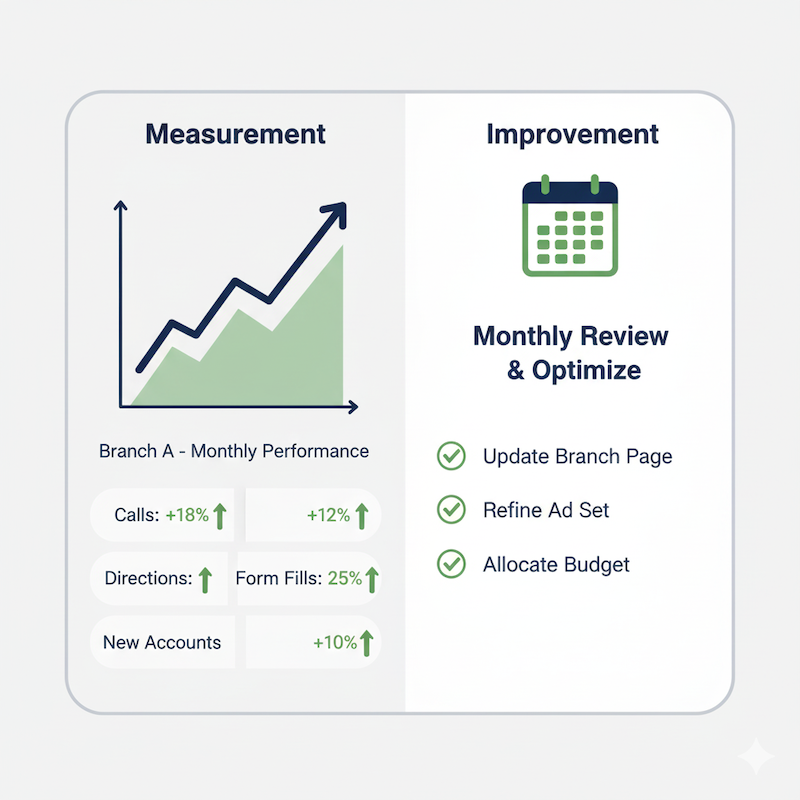Estimated reading time: 7 minutes
TL;DR: Local SEO For Banks And Credit Unions
Local SEO helps banks and credit unions get discovered in “near me” searches before customers step into a branch. Focus on: Speeding up & securing your site for mobile and AI search. Done well, it drives new members, builds trust, and levels the playing field with national banks. Claiming & optimizing Google Business Profiles. Building branch-specific local pages. Gathering and responding to reviews, and Ensuring NAP consistency across directories.
Related Links
1. Why Local SEO Matters For Banks
- Consumer Expectation: Customers no longer drive around looking for branches; they Google them. Studies show 80% of consumers check a bank’s site before visiting in person.
- Competitive edge: Big banks dominate TV ads. Local SEO gives credit unions and community banks a cost-effective way to compete for search visibility.
- Trust through visibility: Appearing in Google’s map pack with fresh reviews signals reliability. If you’re missing, you risk losing trust before the first contact.
Action: Audit your visibility by searching “bank near me” or “credit union [your city].” Note who appears in the top 3 map listings. If you’re not there, you’re invisible to most searchers.

2. What Is Local SEO? (Vs General SEO)
- General SEO aims for broad searches like “checking accounts” or “auto loans.” Hard to win because of national brands.
- Local SEO zooms in on intent: “mortgage lender in St. Louis” or “credit union near downtown Dallas.” These convert because searchers are ready to act.
- YMYL stakes: Banking is “Your Money, Your Life.” Google expects higher quality signals—expert authors, citations, accurate financial advice.
Action: Map your keywords into two buckets: “broad” and “local.” Prioritize the local ones in meta titles, headers, and GBP posts.
3. Optimize Google Business Profiles & Listing
- Claim & verify every branch: If you have 5 branches, you need 5 separate profiles.
- Fill every field: Services, accessibility, hours, phone, attributes (e.g., drive-through, ATM).
- Add photos & posts: Real staff, events, interior/exterior shots. Update weekly with posts about offers or community events.
- NAP consistency: Make sure your name, address, and phone number are exactly the same across GBP, Yelp, Bing, Apple Maps, and industry directories.
Action: Use a tool like Moz Local or BrightLocal to scan for inconsistent citations. Fix them systematically.
4. Localized Pages And Content
- Branch pages: Create unique landing pages for each location with embedded maps, staff introductions, and directions.
- Geo keywords: Use “[service] in [city]” naturally in headers and copy.
- Local blogs: Write about local housing markets, student loan advice for nearby colleges, or recap your community sponsorships.
- Long form: Aim for 1,500–2,000 words of helpful, original content.
Action: For each branch, interview one staff member and turn it into a “Meet Our Team” spotlight. Add it to that branch’s page with their picture. This gives Google fresh content tied to your local entity.
5. Encourage And Manage Reviews
- Ask, don’t wait: Most happy customers won’t leave reviews unless prompted. Train tellers and service reps to ask after positive interactions.
- Make it easy: Provide QR codes on receipts or flyers linking directly to your GBP review form.
- Respond fast: Acknowledge every review within 48 hours. Thank people for praise, and politely address complaints.
- Leverage reviews: Feature them on your site or in social posts.
Action: Build a simple monthly email that thanks members and asks for feedback with a direct GBP link. Automate it for new account openings.
6. Technical And Mobile Optimization
- Mobile-first: 70% of traffic is mobile. Your site must load quickly and look good on phones.
- Speed: Compress images, enable caching, reduce scripts. Aim for <2.5 seconds on Core Web Vitals.
- Security: HTTPS is a trust signal. Ensure SSL certificates are valid.
- Structured data: Implement LocalBusiness schema and FAQ schema to surface in AI/voice search.
Action: Run a PageSpeed Insights test on each branch page. Fix flagged issues like uncompressed images or unused CSS.

7. Build Authority And Backlinks
- Local partners: Sponsor high school sports, community events, or non-profits. Ask for backlinks from their sites.
- Industry credibility: Contribute guest posts to financial education blogs or local newspapers.
- Community signals: Showcase charity drives, financial literacy workshops, or scholarship programs with photos and links.
Action: Create a “Community Impact” hub on your site and link to press mentions, partner sites, and blog posts about local outreach.
8. Measure, Adapt, And Watch AI Search
- Track GBP insights: Calls, clicks, and direction requests.
- Analytics & Search Console: Monitor impressions, ranking shifts, and conversion metrics.
- AI & voice readiness: Structure content in Q&A format so assistants like Siri or Google Assistant can pull direct answers.
Action: Each quarter, review your top 10 search queries in Google Search Console. Create FAQ-style blog posts answering those exact queries.
9. SEO Concepts Every Bank Should Know
- NAP Consistency – Inconsistencies confuse Google. Standardize it once and audit quarterly.
- Google Business Profile (GBP) – The #1 ranking factor for local packs. Keep it fresh.
- E-E-A-T – Showcase credentials, experience, and testimonials to reinforce trust.
- Schema Markup – Add LocalBusiness, FAQ, and Review schema to give context to search engines.
- Mobile-First Indexing – Google ranks the mobile version first, not desktop.
- Local Citations – Get listed on chamber of commerce, Better Business Bureau, and industry directories.
- Review Signals – Google factors in review quality, quantity, and freshness.
FAQs: Local SEO For Banks And Credit Unions
What’s the difference between local SEO and regular SEO?
Local SEO targets “near me” and geo-specific searches, while general SEO focuses on broad keywords.
Why invest in local SEO if we already have branches?
Because most members start online. If you’re not visible, they may choose another bank before visiting.
How do we optimize our Google Business Profile?
Fill out every field, add photos, keep hours current, post updates, and maintain NAP consistency.
Do we need separate pages for each branch?
Yes. Each location deserves a dedicated, optimized page.
How many reviews are enough?
There’s no fixed number. Consistency and responsiveness matter more than volume.
Key Takeaways: Local SEO For Banks And Credit Unions
- Local SEO is the most effective way for banks and credit unions to compete with national brands.
- GBP optimization and NAP consistency are must-do first steps.
- Branch pages + local content = visibility and trust.
- Reviews are both a ranking signal and a trust signal.
- Fast, mobile-friendly, secure sites are non-negotiable.
- Backlinks from local organizations add authority.
- AI and voice search reward concise, structured answers.
Wrapping It Up
Local SEO is no longer optional for banks and credit unions. Customers expect accurate, up-to-date, and trustworthy information before they ever step inside your branch. By investing in branch-level optimization, consistent reviews, localized content, and technical SEO, you give your institution a clear edge over larger national competitors.
Think of it this way: a well-optimized branch listing is the new front door of your bank. If it is inviting, clear, and regularly updated, more people will walk in. If it is outdated or inconsistent, they may walk right past to a competitor.
As you move forward, treat SEO not as a one-time project but as an ongoing operational discipline. Make it part of your quarterly planning, tie it directly to branch KPIs, and use it as a tool to showcase the personal trust and service that only community banks and credit unions can provide. Contact Matchbox Design Group for your Bank and Credit Union local SEO.



